Webb Celebrates Two Years with a Spectacular View of Interacting Galaxies
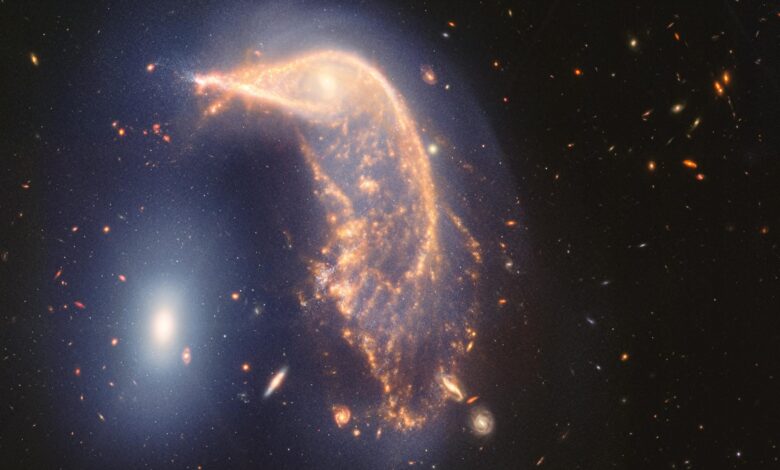
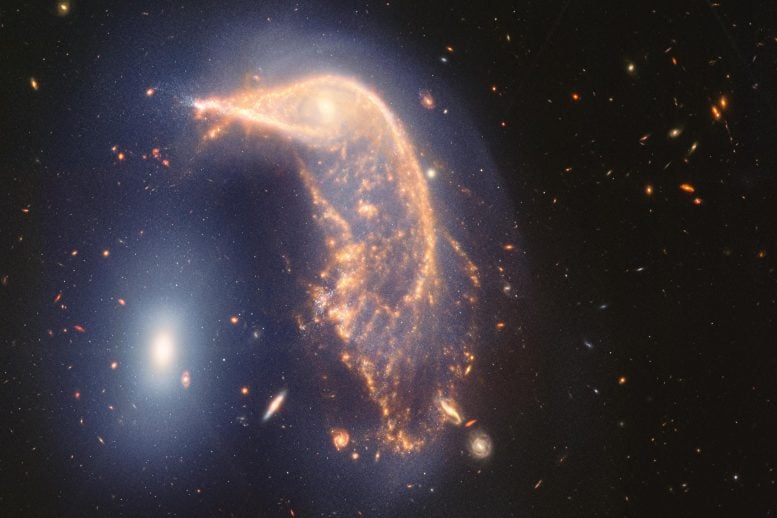
The James Webb Space Telescope, celebrating its second anniversary, captured stunning images of the interacting galaxies known as Arp 142. Using infrared technology, Webb showcased the detailed interaction between the Penguin and the Egg galaxies, revealing new star formations and offering insights into galactic dynamics and evolution. Credit: NASA, ESA, CSA, STScI
NASA’s James Webb Space Telescope shows off a pair of intertwined galaxies in infrared light, its latest release in an ongoing run of observations.
The James Webb Space Telescope operates around the clock, frequently astonishing researchers with its highly detailed — and incredibly precise — infrared images and data. These wavelengths of light, which lie beyond what our eyes can see, were largely out of reach at this level of detail until Webb began taking science observations July 12, 2022, on behalf of astronomers worldwide.
To honor its second anniversary of science, the telescope observed Arp 142, an interacting galaxy pair nicknamed the Penguin and the Egg. The main image combines near- and mid-infrared light, which visually underscores how the galaxies are interacting — look for the faint upside-down blue U shape that envelops both galaxies — along with a “star party,” an abundance of recent star formation, in the Penguin.
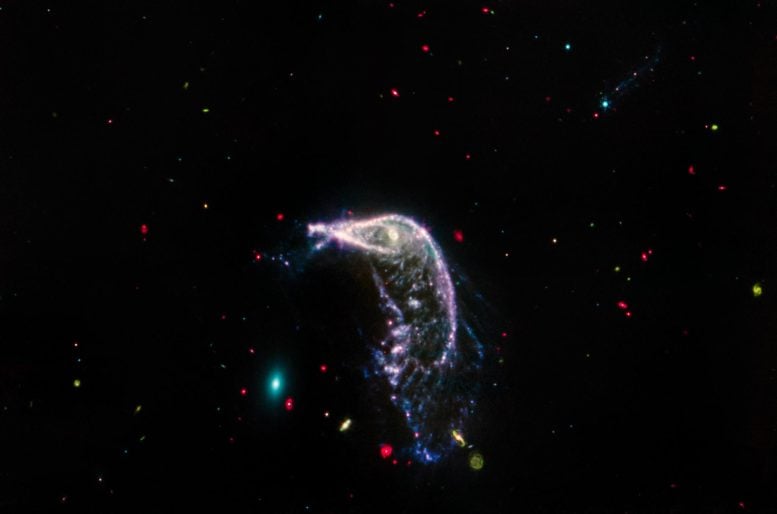
Webb’s mid-infrared view of interacting galaxies Arp 142 seems to sing in primary colors. The background of space is like a yawning darkness speckled with bright, multi-colored beads. This image was taken by MIRI, the telescope’s Mid-Infrared Instrument, which astronomers use to study cooler and older objects, dust, and extremely distant galaxies. Credit: NASA, ESA, CSA, STScI
Vivid Portrait of Interacting Galaxies Marks Webb Space Telescope’s Second Anniversary
Two for two! A duo of interacting galaxies commemorates the second science anniversary of NASA’s James Webb Space Telescope, which takes constant observations, including images and highly detailed data known as spectra. Its operations have led to a “parade” of discoveries by astronomers around the world.
“Since President Biden and Vice President Harris unveiled the first image from the James Webb Space Telescope two years ago, Webb has continued to unlock the mysteries of the universe,” said NASA Administrator Bill Nelson. “With remarkable images from the corners of the cosmos, going back nearly to the beginning of time, Webb’s capabilities are shedding new light on our celestial surroundings and inspiring future generations of scientists, astronomers, and explorers.”
“In just two years, Webb has transformed our view of the universe, enabling the kind of world-class science that drove NASA to make this mission a reality,” said Mark Clampin, director of the Astrophysics Division at NASA Headquarters in Washington. “Webb is providing insights into longstanding mysteries about the early universe and ushering in a new era of studying distant worlds, while returning images that inspire people around the world and posing exciting new questions to answer. It has never been more possible to explore every facet of the universe.”
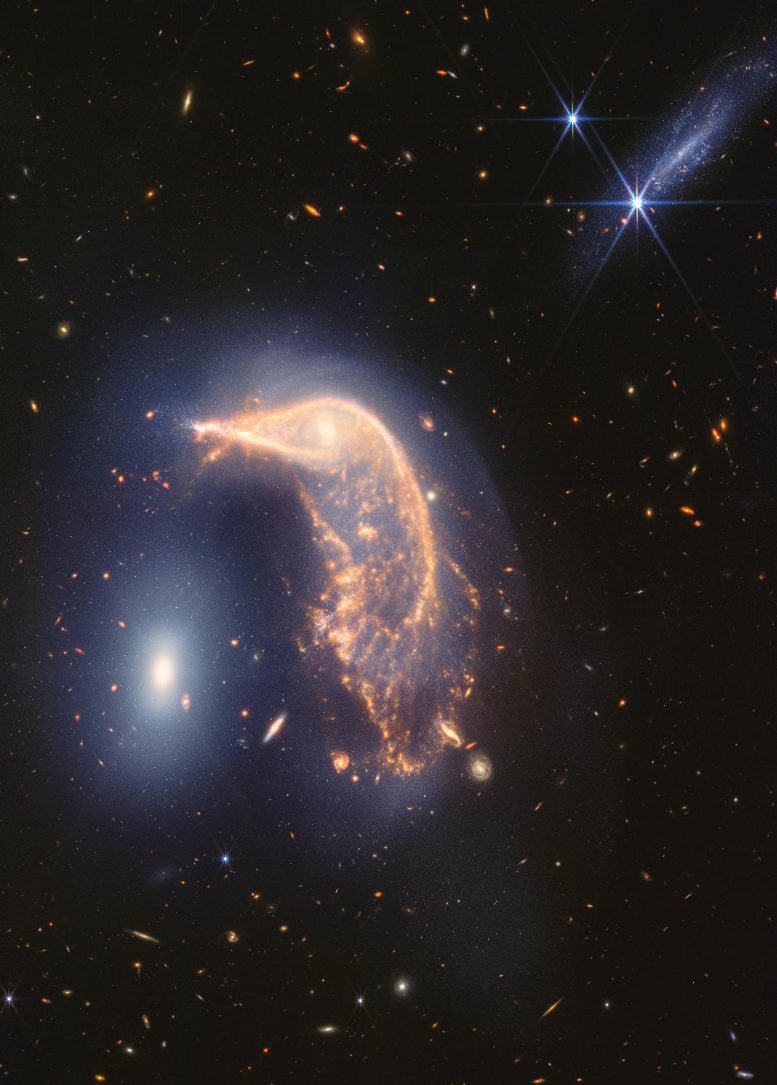
This “penguin party” is loud! The distorted spiral galaxy at center, the Penguin, and the compact elliptical galaxy at left, the Egg, are locked in an active embrace. A new near- and mid-infrared image from the James Webb Space Telescope, taken to mark its second year of science, shows that their interaction is marked by a faint upside-down U-shaped blue glow.
The pair, known jointly as Arp 142, made their first pass between 25 and 75 million years ago — causing “fireworks,” or new star formation, in the Penguin. In the most extreme cases, mergers can cause galaxies to form thousands of new stars per year, for a few million years. For the Penguin, research has shown that about 100 to 200 stars have formed per year. By comparison, our Milky Way galaxy (which is not interacting with a galaxy of the same size) forms roughly six to seven new stars per year.
Credit: NASA, ESA, CSA, STScI
Insightful Observations of Galactic Interactions
The telescope’s specialization in capturing infrared light — which is beyond what our own eyes can detect — shows these galaxies, collectively known as Arp 142, locked in a slow cosmic dance. Webb’s observations, which combine near- and mid-infrared light from Webb’s NIRCam (Near-Infrared Camera) and MIRI (Mid-Infrared Instrument), respectively, clearly show that they are joined by a haze represented in blue that is a mix of stars and gas, a result of their mingling.
Their ongoing interaction was set in motion between 25 and 75 million years ago, when the Penguin (individually cataloged as NGC 2936) and the Egg (NGC 2937) completed their first pass. They will go on to shimmy and sway, completing several additional loops before merging into a single galaxy hundreds of millions of years from now.
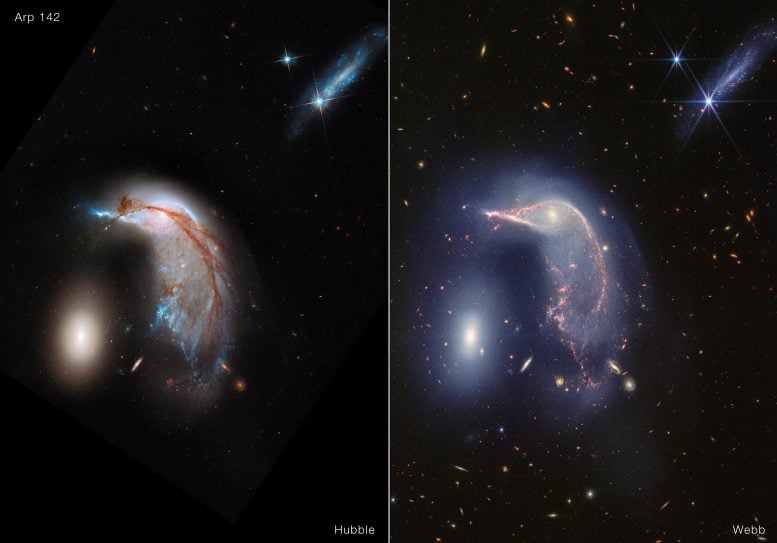
Two penguins, two eggs — two very different color schemes! The Hubble Space Telescope captured visible light when observing Arp 142, nicknamed the Penguin and the Egg, in 2013. At right is the James Webb Space Telescope’s near-infrared light view of the same region. Credit: NASA, ESA, CSA, STScI
Evolution of the Penguin and the Egg
Before their first approach, the Penguin held the shape of a spiral. Today, its galactic center gleams like an eye, its unwound arms now shaping a beak, head, backbone, and fanned-out tail.
Like all spiral galaxies, the Penguin is still very rich in gas and dust. The galaxies’ “dance” gravitationally pulled on the Penguin’s thinner areas of gas and dust, causing them to crash in waves and form stars. Look for those areas in two places: what looks like a fish in its “beak” and the “feathers” in its “tail.”
Surrounding these newer stars is smoke-like material that includes carbon-containing molecules, known as polycyclic aromatic hydrocarbons, which Webb is exceptional at detecting. Dust, seen as fainter, deeper orange arcs also swoops from its beak to tail feathers.
In contrast, the Egg’s compact shape remains largely unchanged. As an elliptical galaxy, it is filled with aging stars, and has a lot less gas and dust that can be pulled away to form new stars. If both were spiral galaxies, each would end the first “twist” with new star formation and twirling curls, known as tidal tails.
Another reason for the Egg’s undisturbed appearance: These galaxies have approximately the same mass or heft, which is why the smaller-looking elliptical wasn’t consumed or distorted by the Penguin.
This video tours Arp 142, an interacting galaxy pair affectionately known as the Penguin and the Egg that lies 326 million light-years from Earth. The journey begins and ends on a new mid- and near-infrared image from the James Webb Space Telescope, and includes a brief fade to a visible light image from the Hubble Space Telescope. The pair are separated by only 100,000 light-years — relatively close in astronomical terms. Our Milky Way galaxy and nearest neighbor, the Andromeda galaxy, are separated by about 2.5 million light-years. This tour spotlights what’s happened since they’ve interacted, including a blue haze that joins them. Also look for contrasting views of the spiral galaxy at top right, which “disappears” in Webb’s mid-infrared view. Credit: NASA, ESA, CSA, STScI, Danielle Kirshenblat (STScI)
The Broader Context of Galactic Interactions
It is estimated that the Penguin and the Egg are about 100,000 light-years apart — quite close in astronomical terms. For context, the Milky Way galaxy and our nearest neighbor, the Andromeda Galaxy, are about 2.5 million light-years apart. They too will interact, but not for about 4 billion years. (See video below.)
This scientific visualization of a computer simulation depicts the inevitable collision between our Milky Way galaxy and the Andromeda galaxy (also known as Messier 31). NASA Hubble Space Telescope observations indicate that the two galaxies, pulled together by their mutual gravity, will crash together in a near-head-on collision about 4 billion years from now.
Now, look to the top right to spot a galaxy that is not at this party. This edge-on galaxy, cataloged PGC 1237172, is 100 million light-years closer to Earth. It’s also quite young, teeming with new, blue stars.
Want one more party trick? Switch to Webb’s mid-infrared-only image (the second image on this page) to see PGC 1237172 practically disappear. Mid-infrared light largely captures cooler, older stars and an incredible amount of dust. Since the galaxy’s stellar population is so young, it “vanishes” in mid-infrared light.
Also take a moment to scan the background. Webb’s image is overflowing with distant galaxies. Some take spiral and oval shapes, like those threaded throughout the Penguin’s “tail feathers,” while others scattered throughout are shapeless dots. This is a testament to the sensitivity and resolution of the telescope’s infrared instruments. (Compare Webb’s view to the 2018 observation that combines infrared light from NASA’s retired Spitzer Space Telescope and near-infrared and visible light from NASA’s Hubble Space Telescope.) Even though these observations only took a few hours, Webb revealed far more distant, redder, and dustier galaxies than previous telescopes – one more reason to expect Webb to continue to expand our understanding of everything in the universe.
This visualization examines the three-dimensional structure of Arp 142, a pair of interacting galaxies nicknamed the Penguin and the Egg, as seen in near-infrared light by the James Webb Space Telescope.
Arp 142 lies 326 million light-years from Earth in the constellation Hydra.
The James Webb Space Telescope is the world’s premier space science observatory. Webb is solving mysteries in our solar system, looking beyond to distant worlds around other stars, and probing the mysterious structures and origins of our universe and our place in it. Webb is an international program led by NASA with its partners, ESA (European Space Agency) and CSA (Canadian Space Agency).



